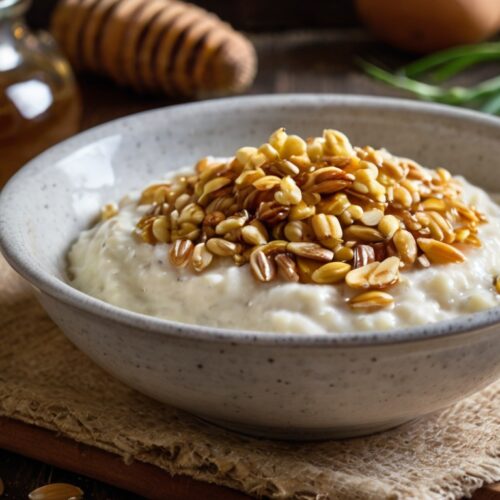The Punic Wars were among the most defining conflicts of the ancient world, shaping the trajectory of Roman dominance and leaving an indelible mark on Mediterranean history. Amidst the tales of epic battles and enduring rivalries, food often plays a quieter but equally vital role.
One such dish is Punic Porridge, a recipe preserved in the agricultural writings of Cato the Elder, a staunch Roman patriot and vocal critic of Carthage.
This simple yet nourishing porridge offers a fascinating glimpse into the culinary connections between Rome and its greatest rival, even as their animosity led to Carthage’s ultimate destruction.
Cato’s De Agri Cultura: A Treasure of Roman Wisdom
Written in the 2nd century BCE, Cato the Elder’s De Agri Cultura (On Agriculture) is the oldest surviving work of Latin prose. A manual for Roman farmers, it provides detailed advice on managing estates, cultivating crops, and preparing food.
Among its many recipes is Punic Porridge, a dish attributed to the Carthaginians. It combines farro (an ancient grain), ricotta (or similar soft cheese), honey, and water, blending simplicity with sustenance.
Cato’s inclusion of a Carthaginian-inspired recipe is intriguing, given his vehement hatred of Carthage. While his political rhetoric often emphasized Roman superiority, his agricultural writing reveals a pragmatic acknowledgment of the ingenuity of other cultures. This dichotomy underscores the complexity of cultural exchange in antiquity, even between bitter enemies.
The Punic Wars: Rome vs. Carthage
The Punic Wars (264–146 BCE) were a series of three conflicts between Rome and Carthage, two superpowers vying for control over the Mediterranean. The first war (264–241 BCE) was fought primarily over Sicily, establishing Rome as a naval force.
The second war (218–201 BCE) brought the legendary Carthaginian general Hannibal into Italy, where he achieved stunning victories, including at Cannae. However, Rome ultimately turned the tide, with Scipio Africanus defeating Hannibal at the Battle of Zama in 202 BCE.
The third war (149–146 BCE) was fueled by Roman fears of Carthage’s resurgence, despite its reduced status. Leading the charge for Carthage’s destruction was Cato the Elder, whose fiery speeches warned of the threat posed by the city’s mere existence.
“Carthago Delenda Est”: The Cry for Destruction
Cato the Elder’s famous phrase, “Carthago delenda est” (“Carthage must be destroyed”), became a rallying cry in the Roman Senate. Cato ended every speech, regardless of topic, with this declaration, underscoring his belief that Carthage’s annihilation was essential for Rome’s security.
His relentless advocacy played a key role in the decision to launch the Third Punic War, which culminated in Carthage’s destruction in 146 BCE.
The fall of Carthage was brutal and absolute. After a lengthy siege, the city was razed to the ground, its inhabitants enslaved, and its lands symbolically salted to prevent future habitation. Rome’s victory solidified its position as the dominant power in the Mediterranean, but it also marked the tragic end of a sophisticated and vibrant civilization.
Punic Porridge: A Culinary Connection
Despite the enmity between Rome and Carthage, Punic Porridge is a testament to the interconnectedness of Mediterranean cultures. The dish reflects the Carthaginian use of grains, dairy, and honey—ingredients readily available and widely consumed in antiquity.
Its simplicity made it a practical meal for farmers and soldiers alike, while its balance of flavors and textures speaks to the ingenuity of ancient cooks.
Recipe: Puls Punica (Punic Porridge)

Punic Porridge (Puls Punica)
Ingredients
- 1 cup farro or substitute barley or spelt
- 1 cup ricotta cheese or fresh soft cheese
- 2 tablespoons honey
- Water for cooking the farro
Instructions
Cook the Farro:
- Rinse the farro thoroughly and place it in a pot with enough water to cover.
- Bring to a boil, then reduce heat and simmer for about 25–30 minutes, or until tender. Drain any excess water.
Combine Ingredients:
- In a mixing bowl, combine the cooked farro (hot) with ricotta cheese.
- Drizzle honey over the mixture and stir to combine.
Serve:
- Serve warm or at room temperature. For added texture, sprinkle with chopped nuts or fresh herbs (optional).
Video
@eatshistory Catos Punic Porridge #history #romanempire #spqr #historybuff #recipe #cooking #historytime #historical #ancient #fyp
♬ Roman Empire – Kley Kley
Notes
- Grain Substitutes: If farro isn’t available, substitute with other ancient grains like spelt, barley, or bulgur for a similar texture and flavor.
- Ricotta Variations: For a tangier option, use goat cheese or a mix of ricotta and Greek yogurt.
- Optional Toppings: Enhance the dish with chopped nuts (walnuts or almonds), fresh herbs, or a sprinkle of cinnamon for added texture and depth.